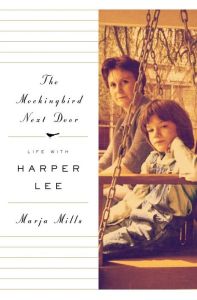Maximum Shelf is the weekly Shelf Awareness feature focusing on an upcoming title we love and believe will be a great handselling opportunity for booksellers everywhere. The features are written by our editors and reviewers and the publisher has helped support the issue.
This review was published by Shelf Awareness on June 25, 2014.
Published in 1960, To Kill a Mockingbird spent nearly two years on bestseller lists and won the Pulitzer Prize in 1961. Since then, its impact has been lasting and widespread: Atticus Finch, Scout, Jem and Dill, and Boo Radley are well-known names today, and the novel is still taught (and targeted for removal) in many high schools nationwide. With its themes of racial injustice, gender roles, mental illness, addiction, and class differences–and its remarkable ability to bring humor and compassion to such somber subjects–To Kill a Mockingbird has become an American classic. Its equally famously author, Harper Lee (full name Nelle Harper Lee, Nelle to her friends), is notoriously private. She stopped giving interviews just a few years after the publication of her only novel. Lee’s relationship with Truman Capote has also attracted longstanding interest. The two grew up next-door neighbors, exercising their imaginations and storytelling talents on one another. Lee assisted Capote’s Kansas research project that became In Cold Blood; Capote is rumored to have contributed to Lee’s Mockingbird, but this rumor has always been hotly denied by Lee (and Capote himself never made such a claim).
Over 40 years after the publication of her masterpiece, Nelle Harper Lee continued to quietly reside in the small Alabama town that inspired it, splitting her time between Monroeville, where her elder sister, Alice, still practices law, and New York City. In 2001, a Chicago Tribune reporter named Marja Mills was assigned to seek out an interview. Knowing Lee’s standing policy, Mills nevertheless traveled to Alabama, filed her request and toured the town for a day or two. She dutifully knocked on the door of Alice and Nelle Harper Lee’s home–and was floored when the elder sister opened the door and invited her in.
The development of trust and friendship between Mills and the Lee sisters took time, but even in those first minutes, the relationship was nearly unprecedented. Alice, the more methodical and steady sister, was first to open up. She set up interviews for Mills with the Lees’ friends and acquaintances, calling ahead to let them know it was okay to talk to the journalist, and what was acceptable to share. Nelle was known to those friends as being more mercurial; but eventually she, too, came around to the younger woman, who was cautious and respectful in approaching the famously cagey writer. Remarkably, Mills does not seem to have begun with any special interest in To Kill a Mockingbird or its author; but as a journalist, she was naturally attracted by the story. In the spirit of The Immortal Life of Henrietta Lacks, Mills then immersed herself in a community that was only just willing to allow her access, and built trust haltingly, but eventually with great success.
Alice was in her 90s, Nelle in her 70s, when the three women become friends. But what could have been a problematic age gap was minimized by Mills’s own chronic health condition, which both helps her identify with the older women, and gives her the dubious gift of leave from full-time work. Eventually, she expressed a tentative interest in moving to Monroeville; the Lees encouraged the idea, and she moved in next door to them. What was by then a close, rich friendship continued to develop: on a daily basis, Mills shared morning coffee with Nelle, drove the countryside, fed the local geese and ducks with the sisters (who kept close tabs on their numbers, and worried over missing goslings), and socialized with the Lees’ close-knit and protective group of friends. This included accompanying Nelle to the Southern society events that made the reticent author nervous.
Alice is the keeper of Lee family lore, with a famously accurate memory. Mills’s research is equally concerned with each of the two sisters, and involves their friends as well. The project that became The Mockingbird Next Door was conceived fairly early in the relationship, and in Mills’s telling, Alice and Nelle are willing supporters; they went over her notes together, marking what was to be included and what was to be redacted. (Readers are left wondering how much fell into the latter category.)
The Mockingbird Next Door offers no big reveals, no shocking secrets about the life of Nelle Harper Lee, except perhaps that she is not a hermit or an incorrigible curmudgeon. Rather, she is a kind, down-to-earth woman, a voracious reader, loyal to her sister and friends–who simply prefers that her life not be such a public performance as was that of her famous former next-door neighbor. Told charmingly in the Lees’ southern drawl and with the affection and closeness that the story reveals, The Mockingbird Next Door is quietly admiring and satisfyingly intimate, and will captivate not only fans of Lee’s great American novel, but fans of real people living modest lives in small-town Alabama, or anywhere.
Come back tomorrow for my interview with Mills!
Filed under: book reviews | Tagged: authors, biography, classics, creative nonfiction, Maximum Shelf, nonfiction, Shelf Awareness |








[…] yesterday’s review of The Mockingbird Next Door, here’s Marja Mills: Making […]